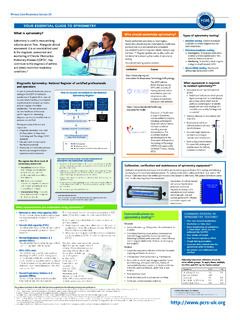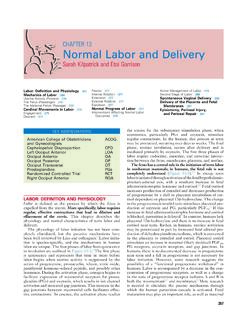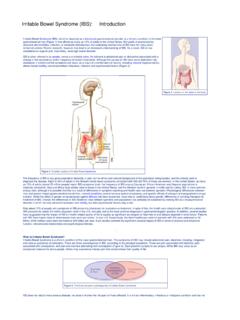Transcription of Risk minimisation in spirometry re-start Introduction
1 Page 1 of 18 Risk minimisation in spirometry re-start Introduction Restoration of spirometry is a key step in managing respiratory disease, ensuring the correct diagnosis and therapeutic / referral interventions. Regrettably due to COVID provision of spirometry in primary / community settings has greatly reduced or ceased. This needs to be addressed with a matter of urgency to limit patient harm, whilst talking opportunities learnt from COVID to deliver better care. Attached are two documents, one from the Association for Respiratory Technology and Physiology (ARTP) and one from the Primary Care Respiratory Society (PCRS) to aid restoration of spirometry services by mitigating risk to both staff and patients. These were developed from a Task and Finish group established by the NHS England and NHS Improvement Clinical Policy Unit and have been reviewed by: Association of Respiratory Nurse Specialists Association for Respiratory Technology and Physiology British Lung Foundation / Asthma UK Partnership British Thoracic Society Royal College of Nursing Primary Care Respiratory Society Feedback from colleagues has highlighted the importance of checking with manufacturers the impact of filters when using hand held devices and the opportunity to use the highest value from either relaxed or forced vital capacity to calculate the FEV1:FVC ratio, something advocated by ARTP.
2 The major issue raised has been the infection and prevention control (IPC) measures and while clearly important it is not the position of the Task and Finish group to make such recommendations. Due consideration needs to be given to: room air changes, the choice of personal protective equipment (PPE), cleaning of room and equipment, the opportunities to reduce risk by considering vaccination status of staff and patients and the use of lateral flow tests. Local IPC advice on these measures must be obtained. Those responsible for providing spirometry are required to have risk assessed the process and ensured that all aspects are safe for both staff undertaking and patients attending the testing, including supply of appropriate PPE. If there is any doubt further advice should be sought from IPC leads. The COVID pandemic has given us the opportunity to consider how we deliver services in primary care and spirometry is an excellent example.
3 Previously delivered mainly in GP surgeries, there is the potential to consider restoration at Primary Care Network (PCN) level, possibly acting as a spoke for the new Community Diagnostic Hubs (CDHs) that will be starting in the near future. Such economies of scale will help with workforce issues and Page 2 of 18 training to ensure spirometry is quality assured and offers the chance to incorporate the use of other appropriate measurements such as exhaled carbon monoxide for assessing smoking and nitric oxide (FeNO) to aid asthma diagnosis, the latter being part of an Accelerated Access Collaborative. We must recognise that restoring services will help with the current patients who need spirometry for confirmation of diagnosis as part of the Quality Outcomes Framework (QOF) that has restarted in April 2021. However, given that spirometry services have been disrupted for over one year, we must also consider how we address the backlog of patients requiring spirometry .
4 This will require focused work at PCN, Clinical Commissioning Group and Integrated Care System level and may be an emergent role for the forthcoming CDHs. Martin Allen spirometry Task and Finish Group Chair Task and Finish Group Membership Name Organisation / role representing Alison Hughes Association of Respiratory Nurse Specialists Andrew Menzies-Gow National Clinical Director, Respiratory Disease Carol Stonham Chair Primary Care Respiratory Society Charlie Sharp Clinical Lead South West Respiratory Network Chris Loveridge Primary Care Network/hub development Irem Patel Clinical Lead London Respiratory Network James Hull Association for Respiratory Technology and Physiology Joanna Purvis Association for Respiratory Technology and Physiology Julie Lloyd Association for Respiratory Technology and Physiology Linda Edwards Education for Health Louise Lomas North East Regional Champion - Primary Care Murugesan Raja Clinical Lead North West Respiratory Network Rachel Hodges British Lung Foundation/Asthma UK Partnership Richard Russell Clinical Lead South East Respiratory Network Sally Welham British Thoracic Society Sarah Elkin Clinical Lead London Respiratory Network Page 3 of 18
5 spirometry in Primary Care Guidance on reinstating spirometry in England Page 4 of 18 The current situation The provision for diagnostic spirometry in primary care was severely disrupted by the COVID-19 pandemic. Whilst there may have been brief intervals when spirometry has been performed, in a limited way, on the whole there has been little activity in primary care since March 2020. There has been a resulting impact on patients with respiratory symptoms, many of whom have been given a provisional diagnosis and await diagnostic spirometry for confirmation of this. Worryingly, some provisional diagnoses will have resulted in patients being prescribed medications they may not need whilst they wait for spirometry testing and results. The exact number of patients caught in the backlog for diagnostic spirometry is unknown but is estimated to be around 200 250 patients per 500,000 population (based on estimates from a CCG database of patients newly prescribed inhaled bronchodilators in the absence of systematic evidence).
6 The actual number of patients may be considerably higher, especially in areas with higher underlying levels of respiratory disease due to local social and industrial factors. As we enter a potentially more stable period in the pandemic with many of the population and most health care providers receiving vaccination against COVID-19, we need to consider how we can safely restart diagnostic spirometry in primary care and manage the risks involved. The service needs to continue to develop from where it was as we entered the pandemic. spirometry should only be provided by appropriately trained health care practitioners who are certified and who are competent and confident in their role. spirometry should be reinstated as a part of the diagnostic pathway for breathlessness, which may be at a Primary Care Network (PCN)-based local diagnostic hublet (or spoke as referred to in the London model) as a PCN delivered spirometry service, or at practice level with a view to moving towards a PCN model in the future.
7 Whichever model is followed, the priority remains to reinstate diagnostic spirometry and there must be a clear assignment of responsibility for ensuring this happens. spirometry as a stand-alone test is insufficient to make an informed respiratory diagnosis. This document has not been written to give clarity on how to perform or interpret quality assured diagnostic spirometry those trained to do so will have completed the required assessment and achieved the required level of competency to deliver the Rather, this document provides guidance on reinstating spirometry in the primary care setting and the management of the ongoing risk that will remain as a legacy of the COVID-19 pandemic. What good looks like There are good examples of network-based respiratory symptom diagnostic service specifications available from the Primary Care Respiratory Society2 and The London 1 Lawlor R.
8 Fit to care: key knowledge skills an training for clinicians providing respiratory care. Available at: 2 Page 5 of 18 Network (2020)3 which present the case for a full diagnostic service, include full protocols for individual procedures of the service and data tracking for evaluation. Recommencing spirometry in primary care needs extra consideration than would have previously been required. Intermediate guidance offered from the South West Respiratory Network gave advice around performing spirometry in a safe but limited way, responsive to the fluctuating infection levels in the community based on the Association for Respiratory Technology & Physiology (ARTP) advice This advice has considered the changing situation with increasing vaccination uptake. Who should perform spirometry ? spirometry should be performed by an appropriately trained health care professional who is certified and registered as competent with the The register defines competence in performing spirometry , interpretation of results, or full (performance and interpretation).
9 It does not include competence in making a When should spirometry be performed? spirometry is performed as part of the diagnostic pathway. Adult patients presenting with symptoms indicative of a respiratory diagnosis should have a full clinical assessment performed, including history and examination, by an appropriately qualified clinician. spirometry may be performed as one of the tests to help confirm a diagnosis, if appropriate. There is a recognised list of relative and absolute contraindications to performing spirometry that trained operators will be familiar In addition, spirometry should not be performed if the patient has any symptoms of COVID-19 infection at the time of the test, or if they are known to have recently been in contact (within previous 10 days) with a confirmed case. Infection control measures spirometry is not considered to be an aerosol generating procedure (AGP).
10 8 However, spirometry -associated cough has the potential to generate aerosol droplets necessitating a mitigation strategy which may include: All tests must be performed using a single use antibacterial antiviral filter. 3 Available via the NHSF utures website 4 5 6 ( 7file:///C:/Users/trace/ (1).pdf 8 Page 6 of 18 The spirometer must be cleaned between patients per manufacturer s COVID-specific instructions. As a minimum this should involve cleaning the outer casing of the transducer and the outer part of the spirometer itself with alcohol wipes. Unless the patient is considered high risk for any reason, operators will need Personal Protective Equipment (PPE) consisting of gloves, apron, visor and Type IIR (surgical) mask. A Perspex screen between patient and operator offers an additional physical barrier for protection.)





